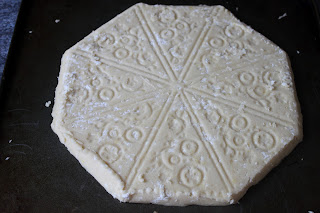I was given/bought myself a shortbread mould last Christmas. It is such a pretty mould and I had great visions of creating shortbread that would not only taste amazing but look beautiful too - perfect homemade Christmas gifts for years to come! But, as with all these things, the mould languished at the back of my cupboard for the last six months unused but not forgotten!
Then last week I decided I really was going to make this beautiful shortbread. I got a recipe for orange shortbread from my mum (I remember having this as a child) and had a go at making my very first batch. Never one to do things by half, I also decided to make this gluten free. Oh dear - the shortbread tasted good but the mould was a disaster! I followed the instructions on the box and pushed the shortbread mix into the mould then left it to chill for 30 minutes. But when I then tried to turn the shortbread out of the mould onto a baking tray it refused to budge. No amount of coaxing could get it out in anything but a crumbled mess. I even put it in again, chilled it for another 30 minutes and had another go and it would not come out! So I ended up scraping it all out and creating a rough circle by hand. So disappointing :o(
I phoned Tesco to complain that their product was rubbish and got through to a Scottish customer service guy who said that as I had bought the product at Christmas I wouldn't be entitled to a refund (I don't agree with him since the mould is not fit for purpose if you can't get the shortbread out , but that would be a whole other story!) We then ended up having a long discussion about shortbread and it
turned out that he makes shortbread all the time and that his two favourite shortbread recipes included almond essence and vanilla essence and coconut ...
Not one for giving in easily, I did a bit of research on the web and decided to have another go. Most of the information on shortbread moulds were for ones that you bake the shortbread in but my mould clearly said not to be used in the oven! So this time, I carefully washed and dried the mould, dusted it with cornflour very thoroughly, pressed the shortbread in very well and left it to chill in the fridge for a very long time (a couple of hours). I also made it with regular wheat flour and decided to add coconut as per Mr Tesco.
This time when I tried to remove the shortbread, I ran a knife around the outside edge several times, tapped the bottom forcefully a large number of times and used a fish slice to try to lift it carefully. Two small sections broke away but then success: the rest of the dough popped out onto the baking sheet. I was able to push the two broken bits back onto the rest and there I had a fairly decent looking shortbread ready for baking.
I'm still not sure how long to cook the shortbread for - most recipes say to remove it before it goes golden but both my shortbreads seemed to be a bit crumbly. Maybe my expectations should be different between home made and shop bought shortbreads. The pattern did show through on this one but still not as much as I had hoped. It may be different without the coconut but we all enjoyed the taste of this in it so it was worth including.
The final verdict? I won't be having a fight with Tesco about fit for purpose goods just yet as I think that with more use the mould and I will develop a better relationship. But I wouldn't recommend buying a non-bakeable mould to anyone thinking about it - it really isn't as easy as the instructions on the back make out!
© 2012 Nicola Noble: Please observe the rules of copyright and blog etiquette. If you use my ideas or images, please link back to my blog. And do let me know - I'd love to take a look.
Monday, 25 June 2012
The trials and tribulations of a shortbread mould!
Labels:
biscuits,
coconut,
shortbread,
shortbread mould
Subscribe to:
Post Comments (Atom)







No comments:
Post a Comment